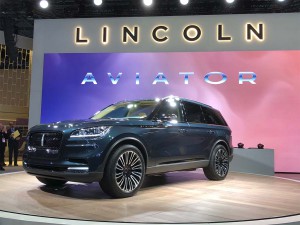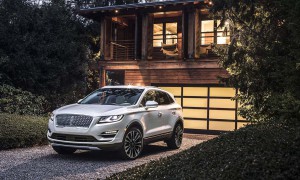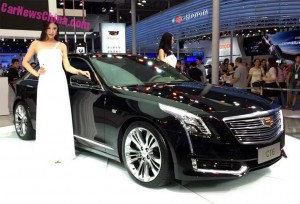Struggling to catch up with rivals now dominating the world’s largest luxury car market, Lincoln plans to start building five new models in China by 2022, according to a report by the Reuters news service.
That’s in line with comments made to TheDetroitBureau.com by Lincoln’s new boss, Joy Falotico, who said she expects China to soon become the brand’s largest market, much as has happened for other luxury marques, including Detroit-based rival Cadillac.
It appears that the new models Lincoln will build in China will also be produced and marketed in other countries, including the U.S. During a backgrounder on the new Aviator SUV prior to its debut at the New York International Auto Show late last month, Falotico revealed that Lincoln plans to launch two new SUVs by 2020, “followed closely by four more vehicles.”
Long starved for product, Lincoln is putting a premium on new utility vehicles, an understandable move considering SUVs and crossover-utility vehicles together account for half the American market and a fast-growing share of the Chinese market, as well.
Among the products that are coming for Lincoln are:
- The 2019 Aviator, which replaces the largely ignored MKT utility vehicle. It will debut in the U.S. and then move to China, with the vehicle produced locally;
- A replacement for the compact MKC crossover which has been one of the brand’s most successful new U.S. editions in years. By the time it reaches China it is expected to adopt a more traditional name, Lincoln abandoning its unsuccessful alpha naming strategy;
- A new version of the MKX, now being updated for the U.S. and renamed Nautilus;
- A replacement for the midsize MKZ sedan, which will also get a new name.
(Click Here for a closer look at the all-new Lincoln Aviator.)
According to the Reuters report, a small, coupe-like crossover is also in the works for 2022. While it would be built and sold in China, the new model is believed to be one of the four Falotico mentioned that will also target the U.S.
Though the luxury brand is not commenting on specific product plans for China, nor the Reuter’s report’s suggestion that there will “hybrid gasoline-electric variants” of the five new Chinese models, Falotico did tell TheDetroitBureau.com last month that “electrification will play an important role in Lincoln’s future,” and nowhere is that more likely the case than in China. That country recently enacted new rules that will require all manufacturers to ramp up sales of zero-emissions vehicles, including both plug-in hybrids and pure battery-electric vehicles.

New Lincoln boss Joy Falotico says electrification will "play an important role" in Lincoln's plans.
There’s another reason that Falotico suggested is more market-driven. While electric drive technology initially was used to focus on fuel economy, luxury brands are now shifting to a mix of performance, driving dynamics and mileage. The upcoming plug-in version of the new Aviator will be the SUVs most powerful drivetrain. It will also emphasize the “quietness,” explained Falotico, that has become a hallmark of the brand.
(Luxury makers embrace plug-ins. Click Here to find out why.)
Lincoln was a latecomer to the Chinese market, launching there only in 2015, and initially through just a handful of dealer. But it has been rapidly expanding its retail network. Sales tripled in 2016 and have continued to grow at a fast pace, even as Chinese demand for Ford-branded products has unexpectedly slowed. Lincoln saw a 66% jump in 2017, and a 60% year-over-year increase in February 2018, the most recent month for which numbers are available.
Even with that rapid growth, Lincoln sold just 54,124 vehicles in China last year, less than a third of the 175,489 vehicles sold there by Cadillac. And it lagged even further behind key German luxury brands like market leader Audi.
One reason why it is struggling to catch up is the reality that all Lincoln models currently are produced in the U.S., while most of its key competitors, including Cadillac, have set up major production bases in China. A total of 17,753 Lincoln MKC crossovers were shipped to China in 2017, according to LMC Automotive, making it third-highest among U.S. vehicle exports to that country. The big Continental sedan was 17th on the list, with shipments of 4,927 vehicles last year.
But that meant Lincoln not only had to tack on shipping charges but a 25% tariff on imported vehicles, a penalty that clearly impacted demand.
“As long as Lincolns are not manufactured in China, the brand’s sales will no doubt suffer continuously,” Zhu Kongyuan, Secretary General of the China Auto Dealers Chamber of Commerce, told Reuters.
(China promises to reduce auto import tariffs – but will it follow through? Click Here for the story.)
That appears to be shaping parent Ford’s decision to add a production base in China for the new Lincoln models. But ongoing trade issues might give the carmaker reason to rethink that move. Earlier this week, Chinese President Xi Yinping said his government plans to “significantly lower” automotive import duties this year. He did not say when, nor indicate if the target comes closer to the modest 2.5% tariff the U.S. levies on most foreign-made vehicles. But if it comes close that could change the Lincoln business equation.
And Ford has shown a willingness to rapidly change production plans. In 2016, the automaker announced it would move small car production from a plant in Michigan to an all-new factory in Mexico. Then, in January 2017, it announced it was scrubbing the second plant and would consolidate production on its existing Mexican assembly line. Months later, Ford shifted gears yet again, revealing the compact Focus model’s operations would move to a plant in China.
Whether Ford would rethink its production plans for Lincoln could depend upon what happens in the wake of the current trade dispute between the U.S. and China. Chinese officials are warning that they could shift the other direction if the dispute escalates, doubling duties on American-made vehicles.
(BMW has big news coming at this month’s Beijing Motor Show. Click Here for more.)




Left hand meet right hand.